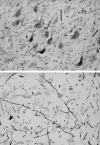Neuroglobin: an endogenous neuroprotectant
- PMID: 17942367
- PMCID: PMC2387246
- DOI: 10.1016/j.coph.2007.09.003
Neuroglobin: an endogenous neuroprotectant
Abstract
Cerebral hypoxia and ischemia trigger endogenous protective mechanisms that can prevent or limit brain damage. Understanding these mechanisms may lead to new therapeutic strategies for stroke and related disorders. Neuroglobin (Ngb), a recently discovered protein that is distantly related to hemoglobin and myoglobin, is expressed predominantly in brain neurons, and appears to modulate hypoxic-ischemic brain injury. Evidence includes the observations that neuronal hypoxia and cerebral ischemia induce Ngb expression, that enhancing Ngb expression reduces--and knocking down Ngb expression increases--hypoxic neuronal injury in vitro and ischemic cerebral injury in vivo, and that Ngb-overexpressing transgenic mice are resistant to cerebral infarction. However, the mechanisms that underlie hypoxic induction of Ngb and neuroprotection by Ngb are still unclear.
Figures


References
-
- Weber RE, Vinogradov SN. Nonvertebrate hemoglobins: functions and molecular adaptations. Physiol Rev. 2001;81:569–628. - PubMed
-
- Hardison R. Hemoglobins from bacteria to man: evolution of different patterns of gene expression. J Exp Biol. 1998;201:1099–1117. - PubMed
-
- Trent JT,, 3rd, Hargrove MS. A ubiquitously expressed human hexacoordinate hemoglobin. J Biol Chem. 2002;277:19538–19545. - PubMed
Publication types
MeSH terms
Substances
Grants and funding
LinkOut - more resources
Full Text Sources
Other Literature Sources
Medical

